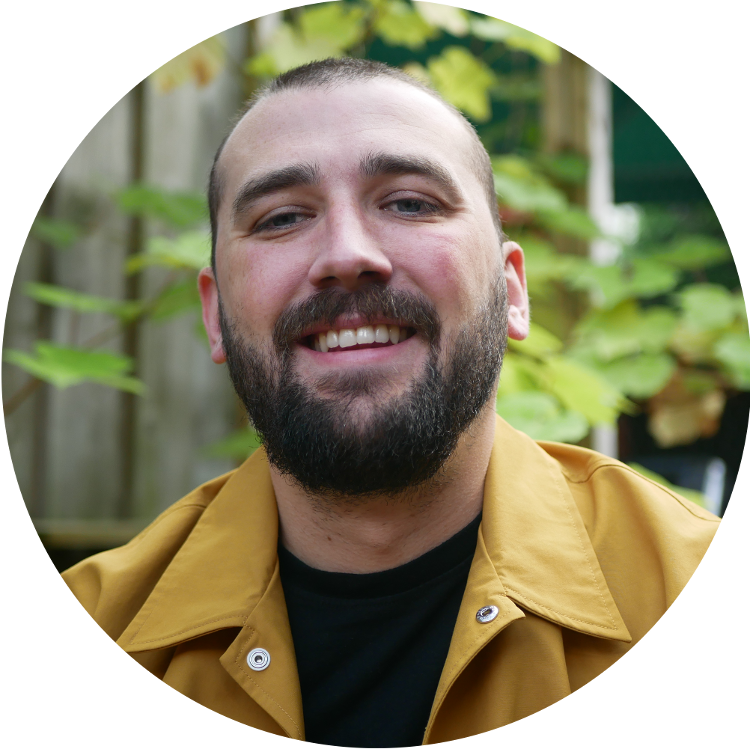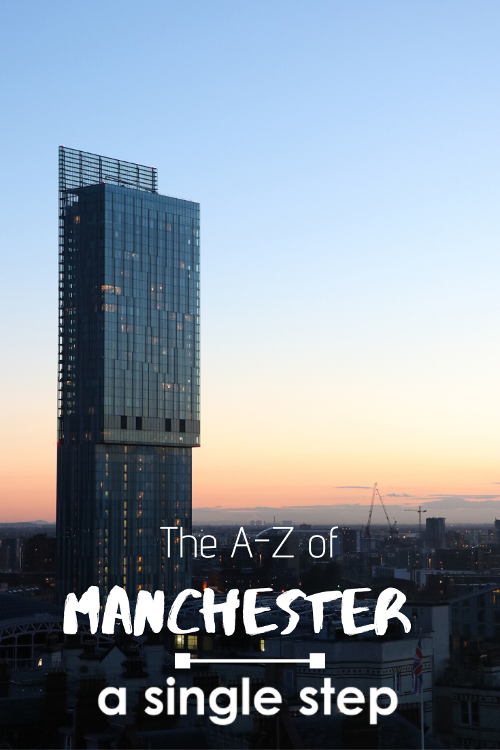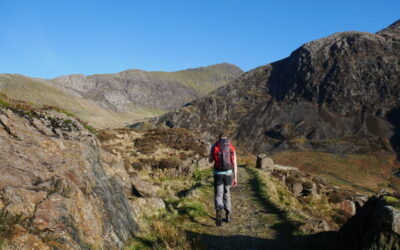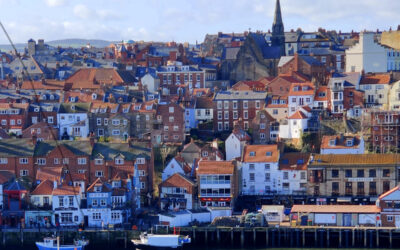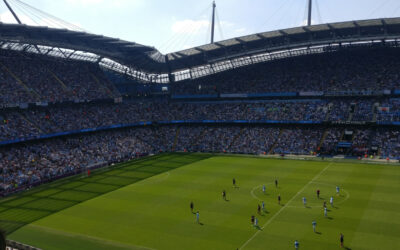Manchester. A post-industrial city grown from cotton and made famous thanks to football and music. A radical city whose citizens have changed the world. A resilient city that has achieved so much and aspires for even more. The only way to fully outline its impact on the world is to explore the city from A-Z.
- A for Alan Turing, Ancoats
- B for Bees, Beetham Tower
- C for Commonwealth Games, Coronation Street, Cottonopolis
- D for Deansgate
- E for Ernest Rutherford
- F for Football
- G for Graphene
- H for The Haçienda
- I for IWM North
- J for Dr. John Cooper Clarke
- K for Karl Marx
- L for Libraries, LGBT+
- M for MIF, Music
- N for Northern Quarter
- O for Oasis
- P for Pankhurst Centre
- Q for The Quays
- R for Radical
- S for Science and Industry Museum, Spinningfields
- T for Town Hall
- U for Universities
- V for Vimto
- W for Warehouse Project
- X for Xmas Markets
- Y for YES
- Z for Z-Arts
A
Alan Turing
The ‘father of modern computing’, Alan Turing was a mathematician and computer scientist, whose legacy has recently been highlighted as due to being chosen as the new face of the English £50 note. During the secon world war, Turing was responsible for devising a number of techniques that helped him and his team break the Enigma code. After the war, Turing worked at The University of Manchester, helping to develop some of the world’s first stored-programme computers.
As a homosexual man in the 1950s, Turing was prosecuted and chemically-castrated, a heinous punishment for which he was post-humously pardoned for in 2013. Alan Turing’s work paved the way for the very devices that we still use to this day.
Ancoats
One of Manchester’s newest and coolest neighbourhoods, Ancoats, to the North of Manchester City Centre, has recently been named 13th in Time Out’s ‘50 coolest neighbourhoods in the world’. Featuring a plethora of new restaurants, hipster cafes, and bars, this hip neighbourhood should be top of your list when visiting the city.
Top picks include Ancoats Coffee Co. for incredible coffee served in a converted warehouse, Rudy’s Pizza for some of Manchester’s finest Naples-inspired Pizza, Canto for modern Portuguese dining, Pollen Bakery for some of the best baked goods in the city, Seven Bro7hers for Manchester-born craft beer, and Hope Mill Theatre for a dose of independent theatre.
B
Bees
You may be confused when you first get to Manchester by the sheer number of bee symbols you will see across the city; on our bins and street furniture, sold in shops, adorning walls as huge murals or graffiti, and even tattooed on our people. The Worker Bee is a symbol of Manchester’s industrial past and hard-working ethic, and was adopted in the industrial revolution. After the 2017 terrorist attack in Manchester, the bee gained even more popularity as a symbol to unify the city and celebrate in its diversity.
Beetham Tower
Love it or hate it, Beetham Tower is an icon of the Manchester skyline. With its own comedic Twitter account (@AngryBeetham), the Beetham Tower was built as the biggest skyscraper in the UK outside of London, and only in 2018 was eclipsed by the South Tower at Deansgate Square. Containing a Hilton Hotel, apartments, and Cloud 23 skybar, the Beetham Tower is also widely recognised for the eerie hum it produces in windy weather.

C
Commonwealth Games
The 2002 Commonwealth Games were hosted in Manchester, after a failed bid for the 2000 Summer Olympics. A huge success for the city, the Games served to highlight how far it had progressed from into a post-industrial city, especially after the IRA bomb in 1996. Reinvigorating development in the centre, the legacy was long-lasting, with the main venue ‘The City of Manchester Stadium’ becoming home to Manchester City Football Club, the Manchester Velodrome being inherited by the now very successful British Cycling, and the purpose-built National Squash Centre and Manchester Aquatics Centre forming a part of the immensely successful SportCity complex in East Manchester. England went on to win 165 medals in the games, including 54 Gold.
Coronation Street
Coronation Street is perhaps Manchester’s most famous, and fictional, street. The TV show is the world’s longest running soap opera, and has been broadcast since 1960. Recently moved to MediaCity, Coronation Street has become a British institution, and fans can tread the famous cobbles on the Coronation Street Tour operated on select dates throughout the year.
Cottonopolis
If there’s one thing that has made Manchester the city that it is today, it is cotton. Named ‘Cottonopolis’ in the 19th Century, Manchester was at one point the most-productive processor of cotton in the world. The wealth that the cotton industry created for Manchester is still evident in the city’s architecture, most notably in the incredible Grade I listed Victorian Manchester Town Hall. After the decline of the cotton trade, Manchester re-established itself as a financial powerhouse of the region, and more recently has utilised the iconic red-brick mills for everything from apartments to offices to hip cafes.
D
Deansgate
Deansgate is the main thoroughfare through Manchester, housing everything from the party-central Deansgate Locks, to the neo-gothic John Ryland’s Library (for more information see L for Libraries). More than just a main road, Deansgate is a historically important part of the city, and one of the oldest thoroughfares through Manchester, passing close to the fort of Mamucium in Roman England, from which Manchester gained its name.
E
Ernest Rutherford
Ernest Rutherford is one of the most important figures in nuclear physics. Born in New Zealand in 1871, Rutherford became a Nobel laureate whilst working at the University of Manchester for research that lead to the very first splitting of the atom, again in Manchester. The discoveries that Rutherford made with his team in Manchester changed the face of science and still remain widely used to this day. (For more Manchester firsts, see R for Radical).
F
Football
What more can you say about Manchester’s football heritage? Wherever you travel in the world, the first thing that people think of when you mention Manchester is football. With two of the world’s best clubs in Manchester City Football Club and Manchester United Football Club, Manchester is now arguably the city at the epicentre of football. On top of the two Premier League teams, Greater Manchester also boasts Championship Bolton Wanderers F.C. and Wigan Athletic F.C., League One Rochdale A.F.C., League Two Oldham Athletic A.F.C. and Bury F.C., as well as a number of other teams including F.C. United of Manchester and Salford City F.C.
For a memorable football day out in Manchester, head to both Manchester United and Manchester City’s club and stadium tours, as well as the fantastic National Football Museum containing 4 floors of football heritage and changing galleries.
View this post on Instagram
View this post on Instagram
G
Graphene
Graphene is a revolutionary new 2D structure first isolated in Manchester by Prof. Andre Geim and Prof. Kostya Novoselov, for which they both won a Nobel Prize in Physics. Flexible, lightweight, and many times stronger than steel, the one atom thick structure has the potential to revolutionise almost every aspect of daily life, with applications from batteries to cars to biomedical uses. Manchester is doubling-down on graphene with the aim of becoming a leader in the research and application of it, opening both the Graphene Engineering Innovation Centre (GEIC) and the National Graphene Institute (NGI).
H
The Haçienda
The Haçienda was perhaps one of Manchester’s most iconic and defining cultural attractions. Opened in 1982 by Factory Records boss Tony Wilson, the music venue became the epicentre of Madchester culture. Although perhaps most famous for its club nights, from which acid house and rave became incredibly popular, The Haçienda also hosted the likes of The Smiths, Madonna, Stone Roses, and New Order.
I
IWM North
IWM North is a purpose-built museum at Salford Quays (for more information see Q for The Quays), covering all aspects of conflict from the First World War onwards. As well as a number of permanent displays including over 2000 historical objects, there is also a number of exhibitions, performances, and activities for the whole family.
J
Dr. John Cooper Clarke
Manchester’s King of Punk and People’s Poet John Cooper Clarke was born in Salford, and rose to fame in the 1970s. Influencing bands such as The Clash and Arctic Monkeys, the inimitable John Cooper Clarke’s often satirical poetry remains as influential as ever, and he can still be found touring his material, as well as appearing on shows such as 8 Out of 10 Cats Does Countdown.
K
Karl Marx
Karl Marx was a German sociologist, philosopher and political theorist, and the co-author of the famous The Communist Manifesto. Along with Friedrich Engels, Karl Marx famously philosophised about the socialism over capitaism. Much of their work and discussions took place in Manchester, specifically in Chetham’s Library where the desk and alcove they worked at during the early 1840s remain intact, along with the books that they studied in the library at the time (for more information see L for Libraries).
L
Libraries
As a recently-awarded UNESCO City of Literature, Manchester clearly has a solid literary heritage, including a number of outstanding libraries.
John Rylands Library is an incredible library launched in 1900 by Enriqueta Rylands, in memory of her husband John Rylands. Based on Manchester’s main thoroughfare Deansgate, the Grade I listed library is one of the most splendid examples of neo-gothic architecture in Europe, and also boasts mesmerising interiors. Alongside a gallery and rotating exhibitions, the library offers a historic reading room and a number of incredibly rare collections.
Manchester’s Central Library in one of the most iconic and architecturally significant buildings in Manchester. The Grade II listed building is adjacent to the Manchester Town Hall and facing St. Peter’s Square. The recently refurbished library has a children’s area, a café, public computers as well as being a typical open public library.
Chetham’s Library is the oldest public-library in the English-speaking world, opening in 1653. Entry to the library is free for those looking to explore the spectacular 15th Century building. Chetham’s hold a wealth of fantastic collections, ranging from 13th Century Medieval manuscripts to books bound in deerskin for Henry VIII himself, making the library a must-visit for any literature or history lovers.
The Portico Library in Manchester is a Grade II listed library based on Mosley Street. Hosting a collection of over 25,000 materials, the library also has a schedule of events and exhibitions to enjoy.
The Working Class Movement Library (WCML) is based in Salford and declares itself as one of the most unusual libraries in the world. Created by two private collectors, Eddie Frow and Ruth Haines, the library focuses on the history of the social and political cultures of the working class people of Britain, and houses everything including leaflets, photography, pottery, archives and much much more.
View this post on Instagram
View this post on Instagram
LGBT+
Manchester’s LGBT+ scene is incredibly welcomed and thriving in the city. Centred around the famous Canal Street and The Village, the celebrations culminate in Manchester Pride – one of the biggest Pride festivals in the country. As well as this, Manchester also hosts The Sparkle Weekend, which is one of the world’s biggest free-to-attend celebrations of gender identity. Manchester is fast becoming known as one of the world-leading gay-friendly cities.
M
MIF
Manchester International Festival (MIF) is a bi-annual festival taking place across the city. The festival is designed to debut new, unique, and innovative work, taking place in everything from theatres and galleries to car parks and railway depots. Boasting previous events including New Order, Arcade Fire, Björk, Maxine Peake, Elbow and much much more, the festival will soon move to a new home inside the purpose-built The Factory – Manchester’s newest flagship cultural venue.
Music
Alongside football, music is now perhaps Manchester’s most defining accolade. The birthplace of world-famous bands such as Oasis, Stone Roses, The Smiths, James, and many many others, Manchester’s musical heritage spans far and wide. Before the Madchester era, The Hollies were one of the country’s most well-loved bands throughout the 1960s. In 1976 The Sex Pistols played Manchester’s Lesser Free Trade Hall in front of an audience of less than 50 (though hundreds of Mancunians will assure you they were in attendance!). The gig went on and changed the face of music in Manchester and across the country forever, as in attendance of this one or the band’s return just a few weeks later, included Morrissey who went on to found The Smiths, the members of Joy Division, a group who later created Buzzcocks, Mark E Smith of The Fall, and Factory Records boss Tony Wilson.
The fruits of this gig came to fruition in the 1980s, where the likes of New Order, The Smiths and The Stone Roses rose to fame amongst the working classes of Thatcher’s Britain. In the late 1980s, the Madchester era truly cemented Manchester as the epicentre of music at the time. Focussed around The Haçienda (for more information see H for The Haçienda), the new cultural scene fused alt-Rock with acid house and dance, with bands such as Happy Mondays, Inspiral Carpets, and James at the front of an incredible wave of Madchester bands that enjoyed a roaring success.
Post-Madchester, Manchester evolved into Britpop, where Oasis’ long-standing musical feud with London’s Blur became an internationally-recognised rivalry (for more information see O for Oasis). To this day, Manchester is still producing some of the best talents in the UK, with bands such as The 1975 and The Courteeners playing around the world. Manchester is also home to institutions such as The Royal Northern College of Music, BBC Philharmonic, and Matt & Phred’s Jazz Club, which are just some of the venues proving that Manchester can cater to all musical interests.
N
Northern Quarter
Manchester’s Northern Quarter remains to this day the independent soul of the city. The area is home to vibrant cafes and bars, independent shops and vintage stores, and quirky street art, with the famous Affleck’s Palace at the heart. Top picks include well-known Piccadilly Records; Evelyn’s Cafe Bar for great brunch; Mackie Mayor for the very best of independent food and drink, in one of my favourite interiors in Manchester; and of course the huge bazaar Affleck’s Palace, full to the brim of alternative and independent gifts and clothing.
View this post on Instagram
O
Oasis
One of Manchester’s most famous musical exports is Noel and Liam Gallagher’s Oasis. The band shot to fame in their early years off the back of the Madchester era, with just their second album (What’s the Story) Morning Glory? selling over 22 million copies worldwide. In 1996, Oasis played their first headline outdoor gig at Manchester’s City’s stadium Maine Road, the team which they famously support. Their popularity culminated later that year when they played two nights at Knebworth to a combined ¼ of million people. With 2.5 million applying for tickets, this is still a record-breaking number for the most in-demand gig of all time. Due to ongoing tensions between the two brothers, the band finally split in 2009, with Noel and Liam founding Noel Gallagher’s High Flying Birds and Beady Eye respectively.
P
Pankhurst Centre
The Pankhurst Centre is one of the most iconic and important centres of women’s rights history in UK. It was home to Emmeline Pankhurst and her family, who was a pioneer of the suffragette movement Women’s Social and Political Union (for more information see R for Radical). The house, located at 60-62 Nelson Street in Manchester, is now a museum that explores and celebrates the fight for women’s right to vote, which was fought and won in this very city.
Q
The Quays
The Quays is an incredible waterfront destination based in Salford, Greater Manchester, and is one of the leading examples of urban regeneration. Previously home to Manchester Docks, The Quays was developed throughout the late-1980s and early-1990s into one of the most popular destinations in the region today.
MediaCityUK is the creative hub of The Quays. Boasting the BBC as anchor tenants, MediaCityUK also hosts ITV, Channel 4, and a number of other creative and TV production companies. The BBC moved to Salford as part of a decentralisation effort from London, and helped to spark the creative industry that has since flourished there.
In terms of visitor attractions, The Quays is second to none. Home to The Lowry, a significant and immensely popular theatre and gallery complex; Old Trafford, Manchester United Football Club’s home ground; Imperial War Museum (for more information see I for IWM North); and a number of other shopping outlets, bars, and restaurants, The Quays should certainly be on your list when visiting Manchester.
R
Radical
Manchester has a history that defines it as a radical city, where ideas and innovation are fostered, and welfare and equality is valued above all.
In 1819, a peaceful demonstration for parliamentary reform in the UK at St. Peter’s Field in Manchester ended with 15 deaths and hundreds of injuries, as cavalry charged throughout the crowd, in what was dubbed the Peterloo Massacre. As the UK, and specifically Northern cities, felt the effects of poor economic conditions, Manchester was at the forefront of the demands on the Government. In 2019, Manchester will mark the bicentenary of the Peterloo Massacre with a number of events across the city.
In 1844, the modern cooperative movement was established by the Rochdale Society of Equitable Pioneers in Greater Manchester, with the Rochdale Principals they developed still used by cooperatives around the world today. In December of 1844, they opened their first store selling necessities such as bread, sugar and flour. This store, at 31 Toad Lane in Rochdale, is now open and available to visit as the Rochdale Pioneers Museum.
During the industrial revolution, Manchester was one of the foremost cities in the world for processing cotton (for more information see C for Cotton). Though this created a tremendous amount of wealth for the region, in 1862 the cotton workers overwhelmingly supported Abraham Lincoln’s blockade of slave-picked cotton, despite the fact that this had a huge effect on the industry of the region. As a thank you to the people of Manchester for their support in this during the civil war, Lincoln wrote a letter to the people of Manchester, including the following:
“under the circumstances I cannot but regard your decisive utterances on the question as an instance of sublime Christian heroism which has not been surpassed in any age or in any country. It is indeed an energetic and re-inspiring assurance of the inherent truth and of the ultimate and universal triumph of justice, humanity and freedom.”
It is for this reason that you can find a statue of Lincoln in Lincoln Square, celebrating the ties forged between the two countries at this time.
Manchester has a place at the heart of the Suffragette movement. Emmeline Pankhurst, born in Manchester’s Moss Side, was the leader of the suffragette movement in the UK and founded the Women’s Social and Political Union (WSPU) in 1903. Dedicated to militant action, Pankhurst and her daughters received prison sentences (often purposely!), staged hunger strikes, and smashed windows of police officers. In 1918, some women were first allowed to vote, and in 1928, all women received the same rights to vote as men. A newly erected statue of Emmeline Pankhurst can be found in St. Peter’s Square in Manchester, and the Pankhurst story can be found at the Pankhurst Centre (for more information see P for Pankhurst Centre)
Rolls-Royce, the luxury British car maker, was established in Manchester. In 1904 Henry Royce met Charles Rolls in The Midland Hotel in Manchester, after which they subsequently agreed a deal to at first sell, and then co-brand all of the cars as Rolls-Royce.
In 1917, Ernest Rutherford, the Chair of Physics at the University of Manchester, was the first person to split the atom. Described by Albert Einstein as “a second Newton”, Rutherford’s studies of the atom changed the face of science and is still in use to this day (for more information see E for Ernest Rutherford).
The world’s first stored-program electronic digital computer was built and ran its first programme in Manchester in 1948. Nicknamed Baby and built by Tom Kilburn and Freddie Williams at the University of Manchester, the success of the project evolved into the Ferranti Mark I, the first commercially available general-purpose computer. You can see a replica of Baby in the Science and Industry Museum in Manchester (for more information, see S for Science and Industry Museum).
In 2004, Prof. Andre Geim and Prof. Kostya Novoselov isolated Graphene at the University of Manchester (for more information see G for Graphene). Winning the Nobel Prize for their work, this wonder-material has the potential to change the world, and the uses are being researched and developed here in the very city it was isolated.
For a full list of Manchester’s radical events, explore this Radical Manchester Timeline.

S
Science and Industry Museum
The Science and Industry Museum in Manchester is a place where children and adults alike can become excited about Science. Located in Manchester’s Castlefield, the museum is situated on Manchester Liverpool Road – the world’s first passenger railway station. With themes that take in Manchester’s transport and innovative heritage, the museum has a number of permanent and temporary exhibitions, galleries and events all year round.
Spinningfields
Spinningfields is one of Manchester’s newest neighbourhoods. With everything from designer shops, fine dining establishments, and premium office space containing the city’s Financial and Professional Services, Spinningfields has become a key district in Manchester, with lots of future development already planned. Top picks include 20 Stories for a rooftop restaurant and bar with incredible views across the city, Tattu for modern Chinese dining and classy cocktails, and The Avenue for your designer shopping needs.
T
Town Hall
Manchester Town Hall is a stunning Grade I listed Victorian neo-gothic building in the heart of the city. Completed in 1877 and designed by the famous architect Alfred Waterhouse, the iconic building is a clear indication of the wealth of the city during the industrial revolution and cotton production (for more information see C for Cottonopolis). Albert Square in front of the Town Hall is a hub for life in the city, home to a number of events, festivals, and Manchester’s famous Christmas Markets (for more information see X for Xmas Markets). Unfortunately, the Town Hall is currently closed for a restoration project and is due to re-open to the public in 2024.
U
Universities
Manchester is a thriving student city, with almost 100,000 people studying at the four Universities; The University of Manchester, Manchester Metropolitan University, The University of Salford, and The University of Bolton. With numerous accolades including ‘Best UK City to Live’ and ‘3rd Most Influential European City’, Manchester has the perfect mix of employment potential, living standards, numerous notable alumni, and a world-class leisure industry to make it the perfect city to study.
V
Vimto
Vimto, one of the nation’s most recognised drinks, was created and manufactured in Manchester in 1908 by John Noel Nichols as an alternative to alcohol during the temperance movement. Originally designed as a health tonic under the name Vim Tonic, the cordial was finally registered as we know it today in 1913. You can now find a statue of a Vimto bottle in Vimto Park in Manchester, located on Granby Row in the spot where the drink was first manufactured.
W
Warehouse Project
The Warehouse Project is a popular series of seasonal club nights in the city, incredibly popular with students. Currently located under Manchester Piccadilly Station on Store Street, The Warehouse Project has also previously been held in a disused Boddingtons factory and Victoria Warehouse. Acclaimed DJs and artists to have played at The Warehouse Project include Carl Cox, Annie Mac, Pete Tong, Calvin Harris, The Prodigy and Basement Jaxx.
X
Xmas Markets
Manchester’s Christmas Markets are certainly among some of the best in Europe. Spanning the length of the city, the award-winning markets include over 300 stalls selling a fantastic array of local and international food, drink and festive gifts, bringing in visitors from across the UK and beyond.
View this post on Instagram
Y
YES
YES is one of Manchester’s newest spaces. Based on Charles Street in the city centre, YES has developed four glorious floors of an old auction house into a haven for music lovers, including a basement venue, 250-capacity live music floor, outdoor terrace and bar. You can also find great food from local favourites Pepperoni Playboy and Firebird Hope, as well as fairly priced beer, coffee and tea. Operated by Manchester-based music promoters Now Wave, YES has a jam-packed calendar of up-and-coming artists.
Z
Z-Arts
Z-Arts is a venue in Hulme offering arts and theatre for young children and families. Aiming to immerse and inspire children through participatory and creative learning, Z-Arts contains 12 public rooms, a 230 seat theatre, gallery, dance studio, music studio, rehearsal and workshop rooms. Z-Arts is also a registered charity, hoping to make a real impact on generations of young people in Manchester.

